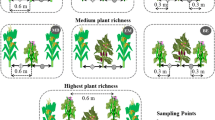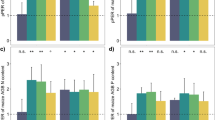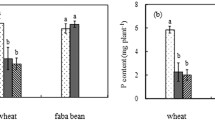Abstract
Interspecific complementary interactions in N, P and K uptake betweenintercropped maize (Zea mays L. cv. Zhongdan No. 2) andfababean (Vicia faba L. cv. Linxia Dacaidou) were investigatedin a field experiment. A root barrier study was also set up in whichbelowgroundpartitions were used to determine the contribution of interspecific rootinteractions to crop nutrient uptake. Nitrogen uptake by intercropped faba beanwas higher than (no P fertilizer) or similar to (33 kg Pha−1 of P fertilizer) that by sole faba bean during theearly growth stages (first to third sampling) of faba bean, and was similar to(no P fertilizer) or higher than (33 kg P ha−1 ofP fertilizer) that by sole faba bean at maturity. Nitrogen uptake byintercropped maize did not differ from that by sole maize at maturity, exceptwhen P fertilizer was applied. Intermingling of maize and faba bean rootsincreased N uptake by both crop species by about 20% compared with complete orpartial separation of the root systems. Intercropping also led to someimprovement in P nutrition of both crop species. Maize shoot P concentrationswere similar to those of sole maize during early growth stages and becameprogressively higher until they were significantly higher than those of solemaize at maturity. Intercropping increased shoot P concentration in faba beanatthe flowering stage and in maize at maturity, and increased P uptake by bothplant species at maturity. Phosphorus uptake by faba bean with rootintermingling (no root partition) was 28 and 11% higher than with complete(plastic sheet) and partial (400 mesh nylon net) root barriers, respectively.Maize showed similar trends, with corresponding P uptake values of 29 and 17%.Unlike N and P, K nutrition was not affected by the presence of root barriers.
Similar content being viewed by others
References
Ae N., Arihara J., Okada K., Yoshihara T. and Johansen C. 1990. Phosphorus uptake by pigeon pea and its role in cropping systems of the Indian subcontinent. Science 248: 477-480.
Al Niemi T.S., Kahn M.L. and McDermott D. 1997. P metabolism in the bean-Rhizobium tropicisymbiosis. Plant Physiol. 113: 1233-1242.
Assemat L., Morishima H. and Oka H.I. 1981. Neighbour effects between rice and barnyard grass strains. Acta Oecologia 87: 551-559.
Böhringer A. and Leihner D.E. 1997. A comparison of alley cropping and block planting systems in sub-humid Benin. Agrofor. Syst. 35: 117-130.
Boucher D.H. and Espinosa J. 1982. Cropping system and growth and nodulation responses of beans to nitrogen in Tabasco, Mexico. Trop. Agric. (Trinidad) 59: 279-282.
Braconnier S. 1998. Maize-coconut intercropping: effects of shade and root competition on maize growth and yield. Agronomie 18: 373-382.
Callaway R.M. and Pugnaire F.I. 1999. Facilitation in plant community. In: Pugnaire F.I. (ed.), Handbook of Functional Plant Ecology. Marcel Dekker, New York, pp. 623-648.
Chamblee D.S. 1958. Some above-and below-ground relationships of an alfalfa-orchard grass mixture. Agron. J. 50: 434-437.
Chiariello N., Hickman J.C. and Mooney H.A. 1982. Endomycor-rhizal role for interspecific transfer of phosphorus in a community of annual plants. Science 217: 941-943.
Chowdhury M.K. and Rosario E.L. 1992. Phosphorus utilization efficiency as affected by component population, rhizobial inoculation and applied nitrogen in maize/mungbean intercropping. Exp. Agric. 28: 255-263.
Crawley M.J. 1997. Plant Ecology. Blackwell Science, Cambridge, UK, pp. 512-513.
Dauro D. and Mohamedsaleem M.A. 1995. Shoot and root interactions in intercropped wheat and clover. Tropic Agric. (Trinidad) 72: 170-172.
Dupraz C., Simorte V., Dauzat M., Bertoni G., Bernadac A. and Masson P. 1998. Growth and nitrogen status of young walnuts as affected by intercropped legumes in a Mediterranean climate. Agrofor. Syst. 43: 71-80.
Gardner W.K. and Boundy K.A. 1983. The acquisition of phosphorus by Lupinus albusL. IV. The effect of interplanting wheat and white lupin on the growth and mineral composition of the two species. Plant Soil 70: 391-402.
Härdter R. and Horst W.J. 1991. Nitrogen and phosphorus use in maize sole cropping and maize/cowpea mixed cropping systems on an alfisol in the northern Guinea savanna of Ghana. Biol. Fertil. Soils 10: 267-275.
Helenius J. and Jokinen K. 1994. Yield advantage and competition in intercropped oats (Avena sativaL.) and faba bean (Vicia faba L.): application of the hyperbolic yield-density model. Field Crops Res. 37: 85-94.
Horst W.J. and Waschkies C. 1987. Phosphorus nutrition of spring wheat (Triticum aestivumL.) in mixed culture with white lupin (Lupinus albusL.). Z. Pflanzenernähr Bodenkd. 150: 1-8.
Jensen S. 1996. Grain yield, symbiotic N2 fixation and interspecific competition for inorganic N in pea-barley intercrops. Plant Soil 182: 25-38.
Jolliffe P.A. and Wanjau F.M. 1999. Competition and productivity in mixtures: some properties of productive intercrops. J. Agric. Sci. (Cambridge) 132: 425-435.
Li L., Yang S.C., Li X.L., Zhang F.S. and Christie P. 1999. Interspecific complementary and competitive interactions between intercropped maize and faba bean. Plant Soil 212: 105–114.
Manson S.C., Leihner D.E. and Vorst J.J. 1986. Cassava-cowpea and cassava-peanut intercropping. III. Nutrient concentrations and removal. Agron. J. 78: 441-444.
May K.W. and Misangu R. 1982. Soybean-cereal intercropping and its implications in soybean breeding. In: Keswani C.L. and Ndunguru B.J. (eds), Intercropping in Semi-Arid Areas. International Development Research Centre, Morogoro, Tanzania, pp. 79-83.
Midmore D.J. 1993. Agronomic modification of resource use and intercrop productivity. Field Crops Res. 34: 357-380.
Perera K.K., Ayres P.G. and Gunasena H.P.M. 1992. Root growth and the relative importance of root and shoot competition in interactions between rice (Oryza sativa) and Echinochloa crusgalli. Weed Res. 32: 67-76.
Piepho H.P. 1995. Implications of a simple competition model for the stability of an intercropping system. Ecol. Model. 80: 251–256.
Regnier E.E., Stoller E.W. and Nafziger E.D. 1989. Common cocklebur (Xanthium strumarium) root and shoot interference in soybeans (Glycine max). Weed Sci. 37: 308-313.
Sangakkara R. 1994. Growth, yield and nodule activity of mungbean intercropped with maize and cassava. J. Sci. Food Agric. 66: 417-421.
SAS Institute 1985. SAS User's Guide: Statistics. Version 5. SAS Institute, Cary, North Carolina.
Stern W.R. 1993. Nitrogen fixation and transfer in intercrop systems. Field Crops Res. 34: 335-356.
Tang C., McLay C.D.A. and Barton L. 1997. A comparison of proton excretion of twelve pasture legumes grown in nutrient solution. Austr. J. Exp. Agric. 37: 563-570.
Tang C., Unkovich M.J. and Bowden J.W. 1999. Factors affecting soil acidification under legumes. III. Acid production by N2-fixing legumes as influenced by nitrate supply. New Phytol. 143: 513-521.
Unkovich M.J. and Pate J.S. 1998. Symbiotic effectiveness and tolerance to early season nitrate in indigenous populations of subterranean clover rhizobia from S.W. Australian pastures. Soil Biol. Biochem. 30: 1435-1443.
Vandermeer J.H. (ed.) 1989. The Ecology of Intercropping. Cambridge University Press, Cambridge, UK.
Walter L.E.F., Hartnett D.C., Hetrick B.A.D. and Schwab A.P. 1996. Interspecific nutrient transfer in a tallgrass prairie plant community. Am. J. Bot. 83: 180-184.
Willey R.W. and Reddy M.S. 1981. A field technique for separating above-ground and below-ground interactions in intercropping: an experiment with pearl millet/groundnut. Exp. Agric. 17: 257–264.
Author information
Authors and Affiliations
Rights and permissions
About this article
Cite this article
Li, L., Zhang, F., Li, X. et al. Interspecific facilitation of nutrient uptake by intercropped maize and faba bean. Nutrient Cycling in Agroecosystems 65, 61–71 (2003). https://doi.org/10.1023/A:1021885032241
Issue Date:
DOI: https://doi.org/10.1023/A:1021885032241




